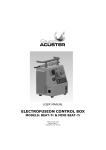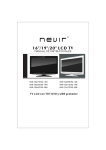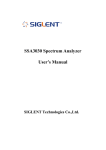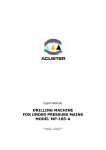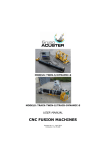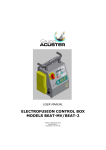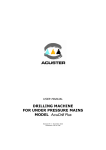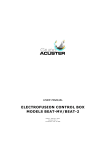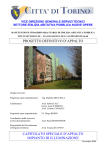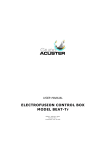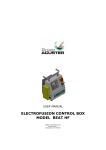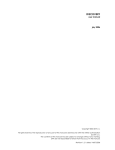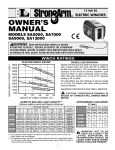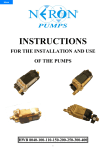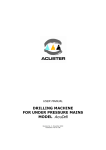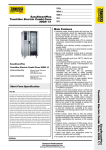Download MU-78-09 TRACK Range
Transcript
USER MANUAL BUTT FUSION MACHINES TRACK RANGE (models from 160 to 1200) Revision No. 1 - June 2008 Publication: MU-78-09E NOTE ! The modifications made with respect to the revision immediately prior to this edition are indicated by using 2 in the right hand margin. USER MANUAL TRACK RANGE CONTENTS: Page: CHAPTER 1: INTRODUCTION........................................................ 1.1 Overview ...................................................... 1.2 Range of models........................................... 1.3 General information........................................ 1.4 Identification of unit ....................................... 1.4.1 Marking of serial No............................... 1.4.2 “EC” marking ....................................... 1.5 Safety measures against accidents ................... 1.6 “EC” declaration of conformity.......................... 1.7 Guarantee ..................................................... 5 5 5 5 6 6 6 7 8 9 CHAPTER 2: DESCRIPTION OF UNIT.............................................. 2.1 General information ........................................ 2.2 Electro-hydraulic station ................................. 2.2.1 Introduction......................................... 2.2.2 Parts of the hydraulic station.................. 2.2.3 Using the hydraulic system ................... 2.3 Connections................................................... 2.3.1 Electric connections ............................. 2.3.2 Hydraulic connections........................... 10 10 12 12 12 13 14 14 14 CHAPTER 3: MODE OF USE............... ........................................... 3.1 Preparing the unit .......................................... 3.1.1 Connecting machine to a power source .... 3.1.2 Verifying temperature of heating plate..... 3.1.3 Hydraulic connections ........................... 3.1.4 Type of hydraulic station........................ 3.2 Butt fusion procedure ..................................... 3.2.1 General criteria for joining...................... 3.2.2 Preparing the pipes and machine ........... 3.2.3 Trimming pipes/fittings.......................... 3.2.4 Heating plate........................................ 3.2.5 Butt fusion procedure ........................... 15 15 15 15 16 16 17 17 17 20 21 21 CHAPTER 4: MAINTENANCE ......................................................... 4.1 General information......................................... 4.1.1 Introduction......................................... 4.1.2 Storage ............................................... 4.1.3 Services............................................... 4.2 Maintenance of base framework ....................... 4.2.1 Hydraulic cylinders, pressure hoses......... 4.2.2 Pipe adaptors........................................ 4.2.3 General cleaning and greasing ............... 24 24 24 24 24 25 25 25 25 Edition: June 2008 Revision: No. 1 GENERAL INDEX - 3 USER MANUAL TRACK RANGE Page: 4.3 4.4. 4.5 CHAPTER 5: 4 Maintenance of heating plate .......................... Maintenance of trimmer ................................ 4.4.1 Trimmer face discs .............................. 4.4.2 Electric motor ..................................... Maintenance of hydraulic station...................... 4.5.1 Introduction........................................ 5.5.2 Maintenance........................................ TECHNICAL CHARACTERISTICS.................................. 5.1 Base framework ............................................. 5.2 Heating plate ................................................ 5.3 Trimmer........................................................ 5.4 Heating plate and trimmer holder..................... 5.5 Hydraulic station ............................................ 5.6 Complete machine........................................... 5.7 Generator specifications................................... 5.8 Documentation............................................... - GENERAL INDEX 25 25 25 26 26 26 26 27 27 27 27 27 28 28 28 28 Edition: June 2008 Revision: No. 1 USER MANUAL TRACK RANGE CHAPTER 1: 1.1 INTRODUCTION OVERVIEW The butt fusion machines of the TRACK range are used for the butt fusion of polythene (PE) tubes and fittings although they can also be used to join other plastic resins (PP, PB, PVDF, ...), in diameters ranging between 50 to 1200 mm (consult models in the following section). The Track range are butt fusion machines equipped with a manually operated electrohydraulic unit. They are of simple construction, ergonomic and easy to handle. The technical data provided in this Manual is purely informative in nature and is subject to changes without prior warning. ACUSTER, S.L., does not make itself responsible for complaints made deriving from the incorrect use of this publication or of the errors and/or omissions that might be detected after publication. This Manual should considered as part of the unit. 1.2 RANGE OF MODELS The range of models available at the time of writing up this Manual are: 1.3 MODEL RANGE OF DIAMETERS TRACK 160 50 to 160 mm TRACK 250 75 to 250 mm TRACK 315 90 to 315 mm TRACK 400 160 to 400 mm TRACK 500 250 to 500 mm TRACK 630 355 to 630 mm TRACK 800 630 to 800 mm TRACK 1200 710 a 1200 mm GENERAL INFORMATION The development, documentation, production, testing and shipping of the products here described have been manufactured: C complying with the applicable security measures, and C in accordance with the quality control requirements guaranteed by ACUSTER, S.L. Edition: June 2008 Revision: No. 1 INTRODUCTION - 5 USER MANUAL TRACK RANGE WARNING ! Only qualified personnel is authorized to carry out tasks either of fusion or of reparation. This qualified personnel must be familiar with all the security measures, potential dangers and maintenance regulations described in this Manual. The safe use of the products described require the appropriate transportation, storing, installation and utilisation, and the careful handling and monitoring of their periodic pre-established maintenance. 1.4 IDENTIFYING THE UNIT 1.4.1 Marking the Serial Number: All the components of the TRACK range of machines: base framework, heating plate, the trimmer and hydraulic station are marked with their corresponding identity plate. ACUSTER S.L. QUALITY CONTROL UNIT Nº " SERVICES " Juan de la Cierva, 1 - Políg. Ind. nº 1 Tel.(34)93 4703070 - Sant Just Desvern (Barcelona) Figure 1 The serial number of the unit is included on the quality control plate. The dates of the services are recorded subsequently in the 5 available boxes. 1.4.2 “EC” Marking: The machines come provided with the plate corresponding to the “EC” marking, complying with the European Union regulations of the new Machinery Directive (Directive 98/37/EC of the European Parliament and Council, of 22nd June, 1998) ACUSTER S.L. EC " MODEL: " SERIAL Nº Juan de la Cierva, 1 - Políg. Ind. nº 1 Tel.(34) 93 4703070 - Sant Just Desvern (Barcelona)- SPAIN Figure 2 6 - INTRODUCTION Edition: June 2008 Revision: No. 1 USER MANUAL TRACK RANGE 1.5 PROTECTION MEASURES AGAINST ACCIDENTS Apply the following safety measures: M Keep the machine beyond the reach of non-authorised personnel, unqualified personnel and children. Protect it from water, rain, snow, etc.. M While moving the machine and during loading and unloading operations, take the necessary safety measures to ensure that all the components of the machine remain perfectly well tied down in the vehicle and that they do not receive knocks during transportation. M Protect the connecting electrical cables of the trimmer, heating plate and that of the connection to the mains, as well as the hydraulic pressure hoses from sharp cutting objects. M Damaged electric cables and hydraulic pressure hoses should be replaced immediately by the Technical Assistance Service of ACUSTER, S.L. M Always connect the unit to power points which have a trip switch and differential. M The machines which are not in use should be kept out of reach of non-authorised personnel. They should be stored in a dry place with restricted access. M Always use appropriate work clothing. For outdoor work, rubber gloves and boots with insulating soles are recommended. In humid regions, these recommendations are essential. For indoor fusion tasks, one should make sure there is sufficient ventilation in the workspace. M Before using the machine each time, its external state must be checked as well as its operating state. All the components must be correctly assembled to guarantee it will function correctly. M Damaged components must be repaired or substituted by the Technical Assistance Service of ACUSTER, S.L. M In the case the machine malfunctions, it must be sent to the Technical Assistance Service of ACUSTER, S.L. immediately. Edition: June 2008 Revision: No. 1 INTRODUCTION - 7 USER MANUAL TRACK RANGE 1.6 “EC” DECLARATION OF CONFORMITY ACUSTER, S.L. Juan de la Cierva, 1 Polígono Industrial Nº 1 08960 Sant Just Desvern we declare under our sole responsibility that the butt fusion m achines of the TRACK range, are m anufactured in agreem ent with the requirem ents of the following Directives based on the following specifications: Directive Related Standards 98/37/EC Safety of m achines EN 1050; EN ISO 12100 EN 61310; EN 954; EN 982 EN 60204-1 2006/95/EEC Low voltage EN 60519-1 2004/108/EEC Electrom agnetic com patibility EN 6100-6-2 Sant Just Desvern, 8 th January 2008 Jaum e Puig General Manager E d ition : Ju n e 20 0 8 8 - INTRODUCTION R e vision : N o. 1 USER MANUAL TRACK RANGE 1.7 GUARANTEE Statement of guarantee: All the butt fusion machines of the TRACK range are manufactured with high quality materials and have been subjected to demanding tests of resistance and operation, passing all the quality controls required in compliance with the applicable regulations (see “EC” Declaration of Conformity). Whatever the case and in the face of any eventuality that might arise during the period of guarantee, we recommend that the following general conditions of guarantee be read carefully. General conditions of guarantee: 1. ACUSTER, S.L. guarantees that this product does not have any manufacturing defects at the time of purchase and extends this GUARANTEE for a period of TWO YEARS. 2. If during this period, the product sustains any kind of defect due to the materials or its assembly, it will be possible to repair it without any extra charge, whether for materials or labour, in the Technical Assistance Service of ACUSTER, S.L.. 3. The Guarantee will not be valid in the following circumstances: When the flaw in the product is due to: 4. C Usual wear and tear resulting from its use. C Abuse or incorrect use of the unit. C Not following the connecting instructions to a power generator as specified in this User Manual. C Repairs carried out without the authorisation of ACUSTER, S.L. C Accidents, natural disasters (including the effects of lightning, water, etc..), as well as any cause unrelated to ACUSTER, S.L. In the claims that might be made against this guarantee, the details related to the model, the date of purchase, serial number, as well as other additional information will need to be made available at all times. Edition: June 2008 Revision: No. 1 INTRODUCTION - 9 USER MANUAL TRACK RANGE CHAPTER 2: 2.1 UNIT DESCRIPTION GENERAL INFORMATION The complete butt fusion machine of the TRACK range is made up of the following components: 1. A base framework (Figure 3), consisting of a frame equipped with handles for transportation (for those models whose weight allows this). The frame incorporates four lower aluminium clamps and four detachable upper clamps made of aluminium too. The base frameworks for large diameter sizes the clamps are made of steel and are supplied with a crane for trimmer and heating plating handling. The securing together of the upper and lower clamps is achieved by use of securing braces equipped with handles which serve as spigots (for large diameter sizes the upper clamps are locked by means of high nuts which require spanner to fix them). Figure 3 The movement of the moveable clamps is achieved via two hydraulic cylinders of double effect, connected to flexible high pressure hoses with quick connectors mounted on the ends. NOTE ! For the care and maintenance of the base framework, consult CHAPTER 4: MAINTENANCE, of this same User Manual. 2. A heating plate (Figure 4), manufactured in aluminium coated with PTFE, with electronic temperature regulation. NOTE ! For the care and maintenance of the heating plate, consult CHAPTER 4: MAINTENANCE, of this same User Manual. 3. A trimmer (Figure 5) activated via an electric motor with chain transmission. It has a safety switch to avoid undesirable actions. NOTE ! For the care and maintenance of the trimmer, consult CHAPTER 4: MAINTENANCE, of this same User Manual. 10 - DESCRIPTION OF THE UNIT Edition: June 2008 Revision: No. 1 USER MANUAL TRACK RANGE Figure 4: Heating plate 4. Figure 5: Trimmer Figure 6: Heating plate and trimmer holder An Electro-hydraulic station (Figure 7a), which integrates the hydraulic pack composed of: electric motor, pump, distributor, pressure throttle (equipped with a pressure limiter), lever to open and close (joystick style), circuit discharge valve lever, quick connectors and an oil deposit (with visor). The large diameter size machines, which are fed at 400 Vac (three-phasic), clamps open-close operation is carried out by push-buttons instead of joystick. Such hydraulic station (Figure 7b) has a distribution box where the trimmer and heating plate are plugged in. Figure 7a: hydraulic station at 230 Vac Figure 7b: hydraulic station at 400 Vac NOTE ! For the care and maintenance of the hydraulic sation, consult CHAPTER 4: MAINTENANCE, of this same User Manual. Edition: June 2008 Revision: No. 1 DESCRIPTION OF THE UNIT - 11 USER MANUAL TRACK RANGE 2.2 ELECTRO-HYDRAULIC STATION 2.2.1 Introduction: The electro-hydraulic station consists of an electric motor, a gear pump, a tank with suction filter, quick connectors and the control levers needed to operate it. WARNING ! Depending on the model of the machine used in the TRACK range, the power of the electric motor and the pump’s capacity varies, as well as other features. Consult CHAPTER 5: TECHNICAL CHARACTERISTICS, of this User Manual. Figure 8a: hydraulic station at 230 Vac Figure 8b: hydraulic station at 400 Vac 2.2.2 Parts of the hydraulic station: Figure 9 12 - DESCRIPTION OF THE UNIT Figure 10 Edition: June 2008 Revision: No. 1 USER MANUAL TRACK RANGE 1 2 3 4 5 6 7 8 Flat-sided quick connectors Electric cable for connection with Schuko type connectors (not shown) Lever for OPEN-NEUTRAL-CLOSED (joystick type) Valve for regulating pressure Lever valve for discharging the hydraulic circuit Pressure gauge Oil tank level visor Cap for oil tank 2.2.3 Use of the hydraulic system: Once the quick connectors of the hydraulic pressure hose of the base framework have been connected to the corresponding connectors of the hydraulic station (1) and the hydraulic station connected to a power source using the electric cable (2), the electrohydraulic station will be operational. Figure 11 Figure 12 Moving the joystick type lever (3) from one side to another (¹ OPEN / ¸ CLOSE), the operation of the electric motor and the pump is activated automatically, and it also serves to open and close the moveable clamps of the base framework. For 400 Vac hydraulic stations, the clamps open-close operations are carried out by pushbuttons. Refer to Figure 7b. The pressure is regulated by means of the control knob (4). Turning the control knob clockwise increases the pressure in the circuit, while turning it anti-clockwise reduces the pressure down to zero. NOTES ! If the knob (4) is in the wide open position, there will be no movement of the moveable clamps given that the pressure in the circuit will be zero or residual. The stud of the control knob (4) has a nut to end the chain transmission which limits the maximum pressure of the circuit. This nut is deliberately blocked in manufacture and the tare weight must not, under any circumstance, be altered. An increase in the circuit pressure could irreparably damage the control pressure gauge (6). Edition: June 2008 Revision: No. 1 DESCRIPTION OF THE UNIT - 13 USER MANUAL TRACK RANGE To carry out the butt fusion cycle, the necessary pressure for the successive phases is adjusted by tightening (increasing the pressure) or untightening (reducing the pressure) the control knob (4). The pressure gauge (6) is used to check the pressure obtained. Once the desired pressure has been set, it is applied by tightening the moveable clamps using the joystick (3), or push-buttons, according to model. To release pressure from Phase 1 to Phase 2, lower the lever of the discharge valve (5). See Figure 12. Raise it again once the pressure of the circuit has decreased sufficiently. NOTES ! The joystick type lever has three positions: Open-Neutral-Close. When it is put in the CLOSED position, the lever remains in that position until it is moved to the NEUTRAL position. When it is put in the OPEN position, it must be kept in position using the hand, returning automatically to the NEUTRAL position when released. To apply the correct parametres of the butt fusion cycle the Fusion Tables must be used depending on the model of the machine and selecting the tube diameter and thickness: refer to the corresponding annexes. 2.3 CONNECTIONS 2.3.1 Electrical connections: Each component of the machine: heating plate, trimmer and electro-hydraulic station, is supplied in series with electric cables of Schuko type connection (for 230 Vac) or type 400 Vac (three-phasic connection), depending on the model. Before connecting, check that the generator or the connection to the power point have the necessary power for the machine to be connected. WARNING ! To consult the necessary power for each of the models of the TRACK range, refer to CHAPTER 5: TECHNICAL CHARACTERISTICS, of this User Manual. 2.3.2 Hydraulic connections: Both the base framework and the electro-hydraulic station have flat-sided quick connectors. With this system, the possibility of an incorrect connection does not exist. 14 - DESCRIPTION OF THE UNIT Edition: June 2008 Revision: No. 1 USER MANUAL TRACK RANGE CHAPTER 3: 3.1 MODE OF USE PREPARING THE UNIT 3.1.1 Electrical connection of the machine: Connect all the components of the machine TRACK (electro-hydraulic station, heating plate and trimmer) to an alternating electricity power point appropriate to the voltage and power of the model being used. IMPORTANT! For the specifications of the machine and generator to be used, refer to CHAPTER 5: TECHNICAL CHARACTERISTICS, of this Manual. Connection to the generator: the connection of the generator to which the unit will be connected will be normalised and equipped with an earth connection and a differential. Refer to the manufacturer’s safety instructions for the generator. Connecting to the mains: the electrical installation of the building where the unit is connected must have an earth and circuit breakers connection with a curve type D (EN 60898). Do not disconnect the plug from the power source pulling directly on the cable. 3.1.2 Verifying the temperature of the heating plate: Once the heating plate has been connected to the power source, it will begin heating until it reaches the set temperature. The temperature at any particular time will be shown in real time on the display screen. Irrespective of the original factory adjustment ( 210EC/225EC, depending on model), you are advised to check the temperature at the beginning of the day or whenever the parameters of the pipes or fittings being used are changed. To do this, press the key . The display screen will show this value. In case of having to modify the existing value, adjust it in the following way: 1. With the heating plate connected to the power source (the upper right led will be lit), press the spanner’s key. 2. The display screen will show the temperature at which the heating plate is set. Press the arrows ª or ©, to decrease or increase the temperature (every press alters it in steps of 5 degrees). 3. Figure 13 Once these steps have been carried out, the display will once again show the present temperature of the heating plate after a few seconds. When the working temperature is reached, the lower right led will go off. Edition: June 2008 Revision: No. 1 MODE OF USE - 15 USER MANUAL TRACK RANGE IMPORTANT! Do not press the arrows ª or © without first having pressed the key with the spanner. If you press it, the display screen will indicate the original factory settings of the differential between the inside and surface temperature. Do not change it. 3.1.3 Hydraulic connections: Connect the two quick connectors to the hydraulic pressure hoses of the base framework to the points of the hydraulic station. Each of the two hoses has a male and female quick connector. Therefore, there is no possibility of confusion in the connection. Open and close the moveable clamps of the base framework with the lever of the joystick to check that the hydraulic action is correct. WARNING ! If there is air in the hydraulic circuit (producing erratic movements when moving the moveable clamps), the circuit draining is automatically achieved carrying out a number of open-close operations: the hydraulic system is provided with a self-purging system. 3.1.4 Type of hydraulic station: On the butt fusion procedure explained on the next clause 3.2, it is stated all the time the use of the hydraulic station which has an input voltage of 230 Vac, which has a joystick type lever to select open, close and neutral positions (Track 160/250, Track 315/400 and Track 500). The hydraulic stations for machines Track 630/800 and Track 1200, are fed at 400 Vac and are provided with push-buttons for clamp open an close operations (instead of joystick). To close and open the movable clamps keep pushed the relevant push-button as many time as it is required: the directional valve is electrically operated by solenoidvalves. 16 - MODE OF USE Edition: June 2008 Revision: No. 1 USER MANUAL TRACK RANGE 3.2 BUTT FUSION PROCEDURE FOR PIPES AND FITTINGS 3.2.1 General criteria for jointing by butt fusion: The chemic-physical characteristics of the materials to be joined using this technique must be compatible with each other, with the compatibility between the materials needing to be certified by the manufacturer of the pipes and fittings. The thickness of the walls of the elements to be joined must be the same, that is to say, belonging to the same series S or PN. The butt fusion must be carried out respecting the following conditions: M Butt fusions must only be carried out by qualified personnel. The workspace where the machine is located must be horizontal, and level. M In the case of humidity, wind or low temperatures, the butt fusion area must be covered with a protecting curtain. The room temperature, measured in the pipes/fittings to be united, should vary between 0EC and +40EC. M The ends of the pipes/fittings to be joined must be sealed by means of protection caps to avoid the cooling of the surfaces to be joined as a result of draughts of air. M The ends of the pipes to be joined must be placed on rollers which enable them to be moved. M The butt fusion machine must always be in perfect working shape, taking care especially to keep it clean and greased. M The non-stick surface of the heating plate must be cleaned before every fusion cycle by using non-fraying paper and alcohol. M The heating plate must be programmed with the correct working temperature depending on the material of the pipes and fittings to be used. M Before carrying out the butt fusion operations, check that the working temperature is stable on the display screen of the heating plate. M To check the temperature of the heating plate, use a digital type contact thermometer or otherwise a pyrometric pencil. If using a pyrometric pencil, the liquefaction of the mark made on the heating plate tells us that the heater is above the specified temperature for the pencil. 3.2.2 Preparation of the pipes and the machine: Î Position the base framework making sure that it is firmly placed on the job spot in this way avoiding any form of movement during the butt fusion cycle that could cause strain on the pipes to be joined. Edition: June 2008 Revision: No. 1 MODE OF USE - 17 USER MANUAL TRACK RANGE Ï Place the electro-hydraulic station and the heating plate and trimmer holder near the base framework. Ð Place the movable clamps of the base framework in wide open position moving the joystick type lever in the direction indicated in Figure 14 (the lever of the discharge valve will be in closed position). Prepare the clamps to the size of the pipes/fittings to be joined. Figure 14 Ñ If joining a pipe with a fitting or a fitting to another, prepare the base framework in such a way that the fitting can be clamped down. The fittings to be butt fused can be, among others: - Elbow joints of 90E, 45E or 30E - Curve of 90E - Tees of 90E (equal or reduced) Ò Figure 15 - Reducer (concentric and eccentric) - Flange adaptor - Cap The exterior clamps of the fixed side (the first of the one on the right as in Figure 16) is removable to accommodate fittings. To detach it, loosen the screws to free the lower clamp and the spacer tubes which attach it to the inner fixed clamp. To set up, follow the sequence in reverse order. Figure 16: Exterior removable clamp 18 - MODE OF USE Edition: June 2008 Revision: No. 1 USER MANUAL TRACK RANGE Ó With the upper clamps dismantled, place the pipes/fittings on each of the sides in such a way that they jut out a minimum distance from the clamps and that it is possible to position the trimmer between the pipes/fittings (before assembling, check the insides and outsides of the pipes/fittings to be fused); make sure that they are level (use support rollers). Figure 15. Ô Mount the upper clamps and fasten the bindings on both sides of the clamp, making sure to tighten them evenly. Õ After assembly, check the alignment of the pipes/fittings. The maximum allowed alignment tolerance according to ISO 12176-1 is 10% of the thickness of the pipes. Correct the alignment by adjusting the upper and lower tautness of the clamps, to that appropriate. Take advantage of this tightening operation to measure the drag. Figure 17 Ö Measure of pull: C C C C Position the pressure regulating valve of the hydraulic station in the wide open position (Figure 18). Position the lever of the joystick in the CLOSED position (Figure 19). Begin closing the pressure regulating valve (clockwise direction) until the moveable clamps move. Have a look at the pressure being indicated by the needle of the pressure gauge. Figure 18 Figure 19 Edition: June 2008 Revision: No. 1 MODE OF USE - 19 USER MANUAL TRACK RANGE 3.2.3 Trimming of the pipes/fittings: â Position the trimmer between the pipes/fittings to be joined, placing them on the bar guides of the base framework and on the face of the pipe tied to the fixed clamps. ATTENTION ! The automatic separating device of the heating plate must be outward facing to avoid interferences with the trimmer. See Figure 21. Figure 20 ã Figure 21 Switch on the trimmer motor. ATTENTION ! Handle the trimmer with caution. There is a risk of being cut by the blades. The trimmer is equipped with a safety switch which prevents it from being switched on if it is not situated on the bar guides. 20 ä Bring the pipes towards the trimmer by means of the joystick lever. Figure 22. å Adding to the drug pressure, already adjusted, the necessary pressure for the blades to begin shaving. æ Trim both pipe ends until the shavings obtained come out in continuous fashion on both sides. At this stage, release the lever of the discharge valve and invert the sense of the action lever to separate the pipes from the trimmer. Figure 22 ç Stop the trimmer motor and raise the lever of the discharge valve. - MODE OF USE Edition: June 2008 Revision: No. 1 USER MANUAL TRACK RANGE è To guarantee that the pipe end sides remain flat, the thickness of the shavings obtained must be the minimum possible (preferably between 0.2 and 0.3 mm, depending on the diameter). NOTE ! If the cut of the blades were not correct, check and adjust following the procedure described in CHAPTER 4: MAINTENANCE, of this User Manual. é Checking the cut obtained: the perpendicularity of the cut of the ends of the pipes will have a maximum tolerance of play (depending on the diameter of the pipe/fitting) between both. P = 0.25 mm for d. # 250 mm P = 0.5 mm for d. > 250 to # 630 mm Figure 23 If the tolerances of the specification to be applied are not attained, trim again. 3.2.4 Heating plate: â Make sure that the temperature of the heater is correct (temperature shown on display screen of 210EC/225EC ± 10EC depending on diameter for PE). ATTENTION ! Hot surfaces! DO NOT touch ! You are recommended to use protective gloves. The working temperature of the plate must be perfectly stable. 3.2.5 Butt fusion procedure: â With the help of the butt fusion Table (see the number of the corresponding Annex of the model being used in Chapter 5 - Technical Characteristics), identify the fusion parameters: once you know the diameter and thickness of the pipe, locate the pressures to apply in the different phases of the butt fusion cycle (you will have to add the necessary drug pressure to move the pipes) and the appropriate times of each phase as well. Edition: June 2008 Revision: No. 1 MODE OF USE - 21 USER MANUAL TRACK RANGE ã Bring the pipes/fittings nearer together. Increase the pressure by turning the knob of the regulating valve clockwise until you achieve the appropriate pressure (initial heating pressure + drag). See Figure 24. Figure 24 ä Open the moveable clamps sufficiently so as to introduce the heating plate. Set the automatic separation device of the heating plate (see Figure 25) and place it on the guide bars of the base framework and between the pipes/fittings to be joined. Bring the pipes/fittings to the heating plate, applying the pressure obtained in clause å Figure 25 ã (initial heating pressure + drag). Figure 24. Put the joystick in the CLOSED position (Figure 24). Let the material flow until a bead of certain thickness is formed (consult the Table). h Figure 26 æ 22 Figure 27 Put the joystick in NEUTRAL and reduce the pressure of the circuit by lowering the lever of the discharge valve until the pressure is the minimum necessary to maintain contact of the heating plate with the pipes (never less than the drag pressure) and raise it once again to block it (Figure 27). Calculate the appropriate time of Phase 2 indicated in the Table. - MODE OF USE Edition: June 2008 Revision: No. 1 USER MANUAL TRACK RANGE ç After a time has elapsed, separate the pipes from the heating plate (¹), remove the heater rapidly and bring the pipe ends together to join them (¸). The maximum opening and closing time should not be greater than the time indicated in the Table (it is recommended that this time be the minimum possible time to avoid the oxidation of the ends of PE to be joined as they are exposed to the room air temperature). Figure 28 Figure 29 è Keep the lever of the joystick in CLOSED position to apply the fusion pressure of Phase 5 indicated in the Table (already adjusted in Phase 1). Keep in this position during the immobilisation stage with the pressure indicated in the Table. é Once the time of Phase 5 has expired, put the joystick in NEUTRAL position and remove the pressure by lowering the lever of the discharge valve (Figure 29) and wait during the immobilisation period without applying pressure (cooling stage) indicated in the Table (Phase 6). ê Once the fusion has terminated, we recommend you take advantage of the cooling time before dismantle the pipes/fittings and to jot down the following data on both sides of the pipes or fittings with a permanent marker: Date Time Operator’s ID Join number ë Once the cooling time has elapsed, check the bead width of the join obtained, comparing it to the margins of tolerance indicated in the Table (if applicable). Edition: June 2008 Revision: No. 1 MODE OF USE - 23 USER MANUAL TRACK RANGE CHAPTER 4: 4.1 MAINTENANCE GENERAL INFORMATION 4.1.1 Introduction: The butt fusion machines of the TRACK range, are equipment designed and built to work for a long time without the need to carry out expensive maintenance repairs; one only has to try to handle them with care when loading and unloading and during transportation (it is recommended to always use the original boxes when transporting), to maintain general cleanliness and to abide by the specified preventive maintenance. The costs of this preventive maintenance are very low and allow for the investment to be regained rapidly, if one has a unit in a perfect working state at all times. This chapter includes those operations of use and general upkeep of the unit. In the case of an anomaly of any kind, carry out the verifications outlined in this Chapter. Nevertheless, it is made clear that any work carried out by unqualified personnel which may go beyond that specified here, could cause damage to the unit, mainly in the hydraulic system. 4.1.2 Storage: In the case of having the unit unused for some time, keep all the components stored in packaging which protect them from dust, humidity, extreme temperatures, direct sunlight, etc.. The placement of the unit within a storeroom can be done directly on the floor or on palletisations shelves. 4.1.3 Services: It is recommended to have a minimum yearly Service of the machine, sending it to the After-sales Service of ACUSTER, S.L. 24 - MAINTENANCE Edition: June 2008 Revision: No. 1 USER MANUAL TRACK RANGE 4.2 BASE FRAMEWORK MAINTENANCE 4.2.1 Hydraulic cylinders, pressure hoses and quick connectors: Check periodically that the hydraulic cylinders do not exude oil and that the drain screws and their joint washer is firmly in place. Check that the hydraulic hoses do not have any cuts or incisions that might cause an oil leak and that the quick connectros are clean and protected from dust and dirt (maintain the oil circuit free from impurities). 4.2.2 Pipe adaptors: Before assembling the pipe adaptors in position, make sure they are clean and fit correctly. Do not tighten the securing screws in excess. 4.2.3 General cleaning and greasing: Always keep the base framework clean and in a perfect condition of use. Clean it after doing a job. Grease the guide bars with a cloth dampened with oil. 4.3 MAINTENANCE OF THE HEATING PLATE Clean it periodically to avoid the PE particles being gradually deposited on the sides of the heater forming an insulating layer which might alter its heating performance when in operation. To clean it, only use white paper or a clean cotton cloth, that does not leave hairs (NEVER EVER use Tangit, isopropanol nor trichloroethylene, especially when the heating plate is hot). 4.4 MAINTENANCE OF THE TRIMMER 4.4.1 Trimmer face discs: Verify the correct cutting of the blades. The shearing of shavings must be uniform and with a recommended thickness of between 0.2 and 0.3 mm on both sides. If the cut is not correct (both in terms of the thickness and eveness of the shavings), proceed to adjust the blade(s). To do this, dismantle the blade and supplement with gauges if necessary. If the edge of the blade shows signs of wear or is nicked, reverse the blade to the other side of the cut (double-edged blades). One must also bear in mind that the adjustment of the blades may vary according to the diameter of the pipes/fittings to be trimmed, needing to be adjusted to adapt to the specific dimension of the pipe size used. Edition: June 2008 Revision: No. 1 MAINTENANCE - 25 USER MANUAL TRACK RANGE 4.4.2 Electric motor (drilling machine or motor): For the trimmer to function the switch of the machine must be activated, putting it on by means of the blockage button of the switch. For this, it is necessary that the trimmer be positioned in the area of work, seeing that the safety switch which it is equipped impedes an inappropriate usage. Check that the switch is working. 4.5 MAINTENMANCE OF THE HYDRAULIC STATION 4.5.1 Introduction: Check the oil level in the visor with which the deposit is equipped. Do this check on a weekly basis. If the level is low, top up with oil using the upper cap to fill the deposit. The original is HYDROL HL-46 for hydraulic systems. WARNING ! Different types of oil must not be mixed in a hydraulic circuit, even though they may have similar characteristics. Always use the same brand and type of oil when adding some to the hydraulic circuit. In the case of not having the oil here specified, substitute the entire system with an equivalent oil approved by the After-sales Service of ACUSTER, S.L. Claims will not be admitted for a breakdown of hydraulic components (piston actuator and operational pump) due to a violation of that mentioned above. 4.5.2 Maintenance: The main cause of leaks is brought on by the infiltration of dirt into the circuit, and thus it is very important to ensure the cleanliness of the hydraulic oil at all times. Other breakdowns in operation might be due to normal wear and tear, as well as flaws or breakages due to incorrect usage. In the case that dirt has penetrated into the circuit, it is very probable that a thorough cleaning will solve many of the problems. It is recommended to send the hydraulic generator to the After-sales Service of ACUSTER, S.L. for an adequate check and repair. 26 - MAINTENANCE Edition: June 2008 Revision: No. 1 USER MANUAL TRACK RANGE CHAPTER 5: TECHNICAL CHARACTERISTICS 5.1 BASE FRAMEWORK MODEL TRACK 160 TRACK 250 TRACK 315 TRACK 400 TRACK 500 TRACK 630 TRACK 800 TRACK 1200 50-160 75-250 90-315 160-400 250-500 355-630 630-800 710-1200 79x39x41 79x44x47 79x55x54 120x65x65 121x66x70 32.5 41 44.5 87.5 107 300 410 --- 90, 110, 125 110, 125, 160, 180, 200 200, 225, 250 250, 280, 315, 355 355, 400, 450 400, 450, 500, 560 630, 710 710, 800, 900, 1000 54x36x12 64x35x17 64x35x17 81x46x24 76x44x36 111x71x35 10 24 18.5 35 68 206.5 Range of sizes Exterior dimensions (cm) Weight without pipe adapters (kg) Set of basic pipe adapters Transport case dimensions (cm) Weight of pipe adapters (with case) (kg) 5.2 TRACK 160 TRACK 250 1000 1900 Voltage (Vac) Power (W) TRACK 315 TRACK 400 TRACK 500 TRACK 630 3100 3800 6800 230 (Mono-phasic) Temperature regulation 2100 146 --- TRACK 800 TRACK 1200 400 (Three-phasic) 8000 16000 Adjustable electronically from 180 to 280°C Coating PTFE Exterior dimensions (cm) Weight (kg) 27x6,5x50 36x12x58 47x11x70 52x12x75 3.35 5.5 7.2 12 64x8x110 82x10x110 85x10x120 160x12x18 17.5 30 46 TRACK 160 TRACK 250 TRACK 315 TRACK 400 TRACK 500 TRACK 630 TRACK 800 500 1010 1010 1100 1100 --- TRIMMER MODEL Voltage (Vac) Power (W) 230 (Mono-phasic) 1010 Cutting blades Exterior dimensions (cm) Weight (kg) 5.4 180x120x140 300x200x200 HEATING PLATE MODEL 5.3 170x115x105 170x115x126 290x170x180 TRACK 1200 400 (Three-phasic) 1100 1500 Double edge, adjustable 36x26x45 41x36x42 46x47x55 62x16x90 8.30 15.3 21.8 35.5 62x23x98 92x25x120 90x25x135 170x300x180 58 TRACK 400 TRACK 500 102 120 --- HEATING PLATE AND TRIMMER HOLDER MODEL Exterior dimensions (cm) Weight (kg) TRACK 160 32x25.5x34 4.22 TRACK 250 TRACK 315 36x33x34 40x37x42 50x42x50 6.5 8 13 TRACK 630 TRACK 800 TRACK 1200 60x60x70 78x78x60 120x100x110 160x140x280 22.5 40.5 90 --- Edition: June 2008 Revision: No. 1 TECHNICAL CHARACTERISTICS - 27 MANUAL DEL USUARIO GAMA TRACK 5.5 ELECTRO-HYDRAULIC STATION MODEL TRACK 160 / 250 Voltage (Vac) TRACK 500 230 (Mono-phasic) Power (Kw) Pressure gauge (bar) Exterior dimensions (cm) TRACK 630 / 800 TRACK 1200 400 (Three-phasic) 0.37 0.55 0.75 0.75 1.10 55 95 150 150 150 Maximum pressure (bar) 0-60 0-100 0-160 0-160 0-160 51x31x41.5 51x31x41.5 51x31x41.5 77x44x47 77x44x47 26.5 29.6 31.5 47.5 56 Weight (kg) 5.6 TRACK 315 / 400 COMPLETE MACHINE MODEL TRACK 160 TRACK 250 Voltage (Vac) TRACK 315 TRACK 400 TRACK 500 TRACK 630 230 (Mono-phasic) Total power (Kw) TRACK 800 TRACK 1200 400 (Three-phasic) 1.87 3.28 3.66 4.66 5.65 8.65 9.85 18.60 Nett weight w/o pipe adapters (kg) 75 95 111 177,6 236,5 520 713,5 --- Nett weight w. pipe adapters (kg) 87 119 137 212.6 304.5 726.5 859.5 --- TRACK 315 TRACK 400 TRACK 500 TRACK 630 TRACK 800 TRACK 1200 6000 7500 11000 5.7 GENERATOR SPECIFICATIONS MODEL TRACK 160 TRACK 250 2500 4000 Voltage (Vac) 230 (Mono-phasic) Advisable minimum power (VA) 5.8 4500 400 (Three-phasic) 12500 24000 DOCUMENTATION: List of documents included with the machine: - User Manual (Publication MU-78-09E) - Table of butt fusion parameters: C C C C C 28 ANX-144 ANX-145 ANX-146 ANX-147 ANX-148 TRACK TRACK TRACK TRACK TRACK 160/250/315 (PE) 400/500 (PE) 630/800 (PE) 1200 (PE) 160/250/315 (PP) - TECHNICAL CHARACTERISTICS Edition: June 2008 Revision: No. 1 USER MANUAL TRACK RANGE RESERVED FOR NOTES Edition: June 2008 Revision: No. 1 TECHNICAL CHARACTERISTICS - 29





























